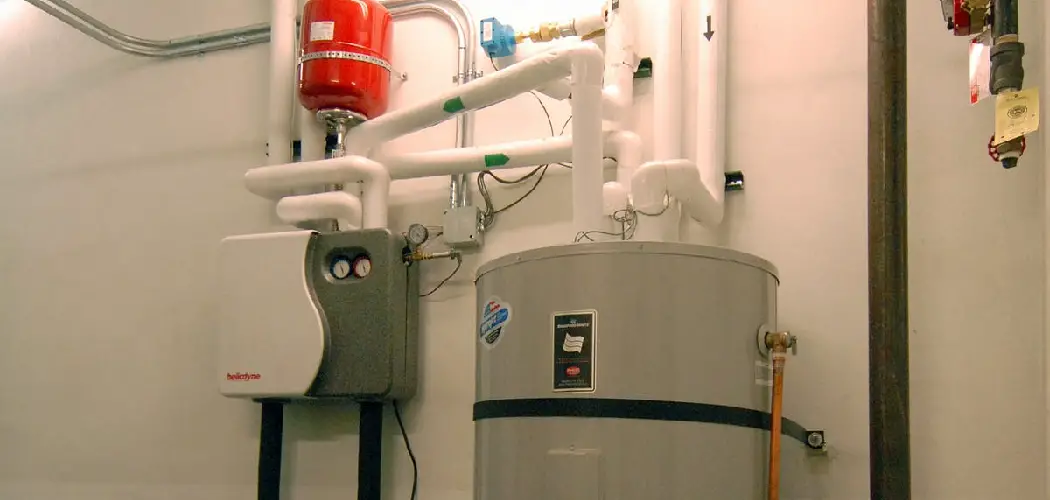Turning off your gas water heater before going on vacation is a practical step to ensure safety and energy savings while you are away. This simple yet effective measure helps prevent potential gas leaks and reduces unnecessary energy consumption, providing peace of mind during your travels. In this comprehensive guide, we’ll explore effective strategies and practical tips on how to turn off gas water heater for vacation. The process involves several key steps to ensure the water heater is safely and correctly shut down.
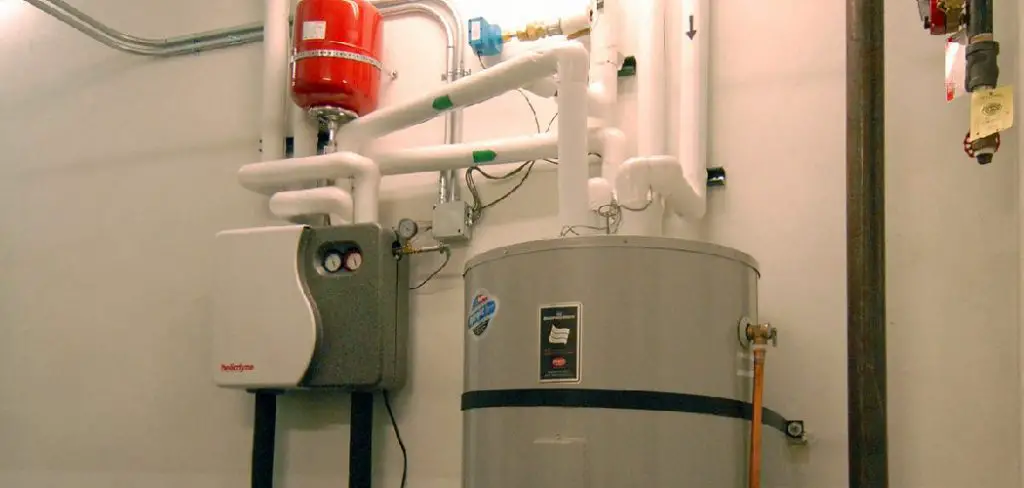
First, familiarize yourself with your water heater’s controls, typically found on the unit’s front panel. Then, turn the thermostat to the “Pilot” or “Vacation” setting, which significantly reduces the unit’s energy usage without fully turning off the pilot light. For extended absences, consider shutting off the gas supply entirely by turning the gas valve to the “Off” position. Additionally, it’s wise to turn off the cold water supply to the heater to prevent any leaks. By following these steps, you can ensure your home remains safe and your energy bills stay low while you enjoy your vacation.
The Importance of Properly Shutting Down a Gas Water Heater
Properly shutting down your gas water heater before leaving for an extended period is crucial for several reasons. First and foremost, it mitigates the risk of gas leaks, which can pose significant safety hazards, including fire and explosion. By turning off the gas supply, you greatly reduce the chances of such dangerous occurrences. Secondly, shutting down the water heater can result in considerable energy savings. Water heaters consume a large amount of energy to maintain water at a set temperature, even when hot water is not being used.
By switching the unit to a lower setting or turning it off entirely, you lower energy consumption, which can lead to noticeable reductions in your utility bill. Lastly, shutting off the cold water supply to the heater prevents potential water damage from leaks or ruptures, thereby safeguarding your property. In essence, taking these preventative steps ensures not only your safety and financial savings but also contributes to the longevity and efficiency of your water heater.
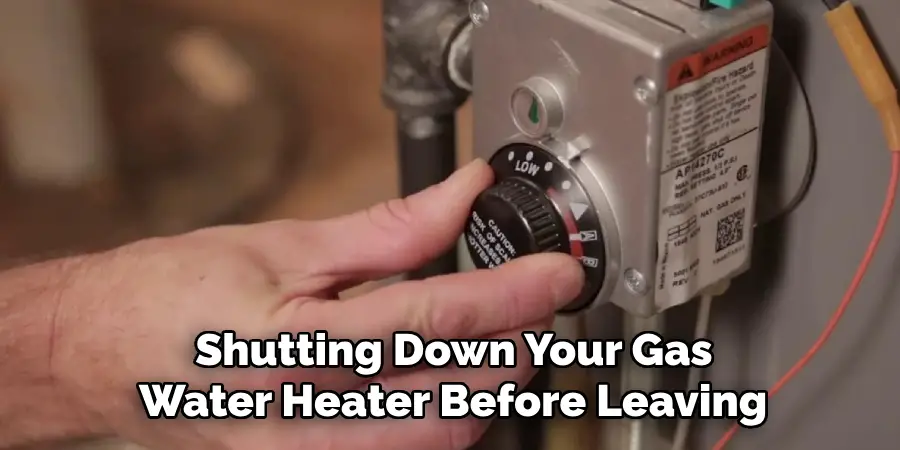
Understanding Gas Water Heaters
Gas water heaters are a popular choice for many households due to their efficiency and ability to provide a continuous supply of hot water. They operate by using natural gas or propane to heat the water stored in a tank. The main components of a gas water heater include the gas control valve, burner, thermostat, and venting system. The gas control valve regulates the flow of gas to the burner, which ignites to heat the water. The thermostat monitors the water temperature and signals the burner to turn on or off to maintain the desired temperature. Finally, the venting system safely expels combustion gases outside the home.
Understanding the functioning of these components is essential for the proper maintenance and troubleshooting of your gas water heater. Regularly checking and cleaning the burner, ensuring the pilot light is functioning correctly, and inspecting the venting system for any blockages or leaks can significantly enhance the lifespan and efficiency of your water heater. Additionally, knowing how to adjust the thermostat and control valve settings can help you manage energy consumption effectively. By familiarizing yourself with the basic workings of a gas water heater, you can ensure its optimal performance and longevity.
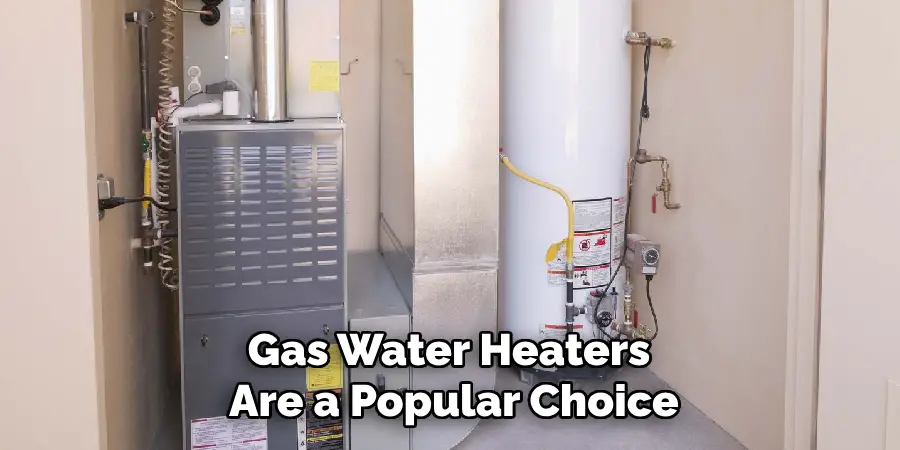
Components of a Gas Water Heater
Understanding the various components of a gas water heater is essential for ensuring its proper functionality and longevity. Here are the key components:
- Tank: The tank is the main body of the water heater where the water is stored and heated. It is typically made of steel and lined with a glass or porcelain coating to prevent corrosion.
- Gas Control Valve: This valve regulates the flow of gas to the burner. It is equipped with safety features like a thermocouple that shuts off the gas supply if the pilot light goes out, preventing gas from leaking into the home.
- Burner: Located at the bottom of the tank, the burner is where the gas is ignited. It heats the water in the tank and is controlled by the thermostat.
- Thermostat: The thermostat controls the temperature of the water by turning the burner on and off. It helps maintain a consistent and desirable water temperature.
- Dip Tube: The dip tube directs cold water from the top of the tank to the bottom, ensuring that the water being heated is always drawn from the coolest part of the tank.
- Anode Rod: This rod is inserted into the tank to attract corrosive elements in the water, thereby protecting the tank from rusting and extending its lifespan.
- Pilot Light or Ignition System: The pilot light is a small, continuously burning flame that ignites the gas burner. Some modern units use an electronic ignition system instead.
- Venting System: Essential for safety, the venting system expels harmful combustion gases like carbon monoxide outside the home. It ensures proper ventilation and prevents dangerous gas buildup.
- Pressure Relief Valve: This safety valve releases excess pressure if the water temperature or pressure becomes too high, preventing potential tank explosions.
- Drain Valve: Located near the bottom of the tank, the drain valve allows you to drain the tank to remove sediment and for maintenance purposes.
- Cold and Hot Water Supply Lines: These lines bring cold water into the tank and deliver hot water to the home’s plumbing system, respectively.
Functionality of a Gas Water Heater
The functionality of a gas water heater hinges on the seamless operation of its integrated components. When cold water enters the tank through the dip tube, it is directed to the bottom of the tank where the burner is located. The thermostat detects the water temperature and, if it falls below the set threshold, signals the gas control valve to release gas to the burner. Once the gas ignites via the pilot light or an electronic ignition system, it generates heat, warming the water in the tank.
As the water heats up, the convection process causes hot water to rise to the top of the tank, ready to be delivered to faucets and appliances via the hot water supply line. Meanwhile, the venting system ensures that any harmful combustion gases produced during the heating process are safely expelled outside the home, maintaining indoor air quality and safety. The pressure relief valve acts as a critical safety mechanism by releasing excess pressure, thus preventing potential damage or explosion.
Regular maintenance tasks such as checking the anode rod for corrosion, draining the tank to remove sediment, and inspecting the venting system for obstructions are vital to ensure the efficient and safe operation of a gas water heater. By performing these actions, you can optimize the heater’s performance, extend its lifespan, and guarantee a continuous supply of hot water for your household needs.
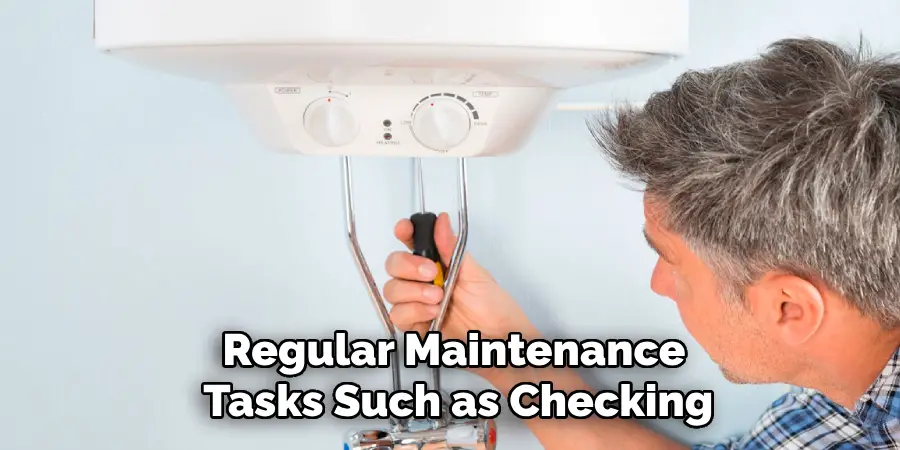
10 Methods How to Turn off Gas Water Heater for Vacation
1. Turn Off the Gas Supply
The first step in turning off your gas water heater is to shut off the gas supply. Locate the gas supply valve, typically found on the gas line leading to the heater. This valve is often a lever that can be turned perpendicular to the gas line to shut off the flow of gas. By turning off the gas supply, you ensure that no gas will flow to the water heater while you’re away, eliminating the risk of gas leaks and potential hazards. This step is crucial for safety and energy conservation during your vacation.
2. Adjust the Thermostat to “Pilot” Mode
Most gas water heaters have a thermostat with several settings, including “On,” “Off,” and “Pilot.” Turning the thermostat to “Pilot” mode maintains the pilot light but prevents the burner from firing up to heat water. This setting is ideal for short vacations as it keeps the pilot light burning, making it easier to restart the heater upon your return. To adjust the thermostat, locate the control knob on the front of the water heater and turn it to the “Pilot” position. This method conserves energy while ensuring the heater remains ready for quick activation when you get back.
3. Turn the Thermostat to “Vacation” Mode
Some modern gas water heaters come equipped with a “Vacation” mode setting on the thermostat. This mode is specifically designed for periods when the water heater will not be in use, such as during vacations. Setting the thermostat to “Vacation” mode lowers the water temperature to a safe but energy-efficient level, preventing the heater from constantly cycling on and off. To activate this mode, simply turn the thermostat knob to the “Vacation” position. This method is convenient and ensures your water heater uses minimal energy while you’re away.
4. Shut Off the Main Water Supply
Turning off the main water supply to your home is another effective way to ensure your gas water heater remains safe and energy-efficient during your vacation. Locate the main water shut-off valve, usually found near where the main water line enters your home. Turn the valve clockwise to close it and stop the flow of water. Shutting off the water supply prevents potential leaks or flooding, especially if a pipe bursts while you’re away. This step also helps reduce pressure on the water heater, further minimizing energy use and risk of damage.
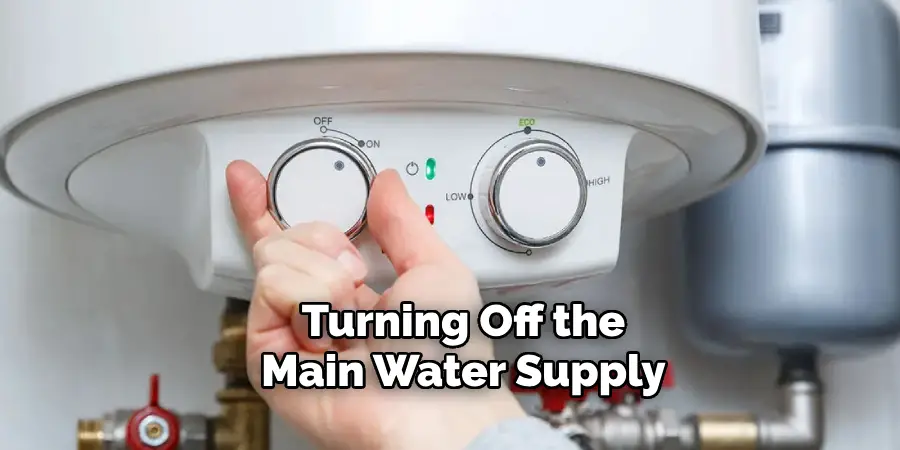
5. Drain the Water Heater Tank
For extended vacations or if you live in an area prone to freezing temperatures, consider draining the water heater tank. Draining the tank prevents water from sitting in the heater and potentially freezing, which can cause serious damage. To drain the tank, first, turn off the gas supply and the water supply to the heater. Attach a garden hose to the drain valve at the bottom of the tank and run the hose to a suitable drainage location. Open the drain valve and let the water flow out until the tank is empty. This method ensures the tank remains free of water, reducing the risk of freezing and damage.
6. Insulate the Water Heater
Insulating your water heater and its pipes can help maintain its temperature during short vacations, reducing the need to shut it off completely. Use a water heater insulation blanket to wrap around the tank and pipe insulation sleeves for the pipes. This insulation helps retain heat, allowing the water heater to use less energy to maintain a lower temperature. While this method doesn’t involve turning off the heater, it can significantly reduce energy consumption and provide added protection against temperature fluctuations.
7. Disconnect the Power Supply
For gas water heaters with electronic controls or an electric ignition system, disconnecting the power supply can be an additional safety measure. Locate the power switch or unplug the unit from the electrical outlet. This step ensures that the electronic components do not draw power or potentially malfunction while you’re away. Disconnecting the power supply provides an extra layer of safety and helps prevent any unforeseen electrical issues during your vacation.
8. Secure the Heater Area
Before leaving for vacation, ensure that the area around your water heater is clear of any flammable materials or clutter. This precaution reduces the risk of fire hazards and allows for proper ventilation. Check for any signs of leaks or damage to the water heater and address them before leaving. Securing the heater area ensures it remains safe and reduces the risk of accidents while you’re away.
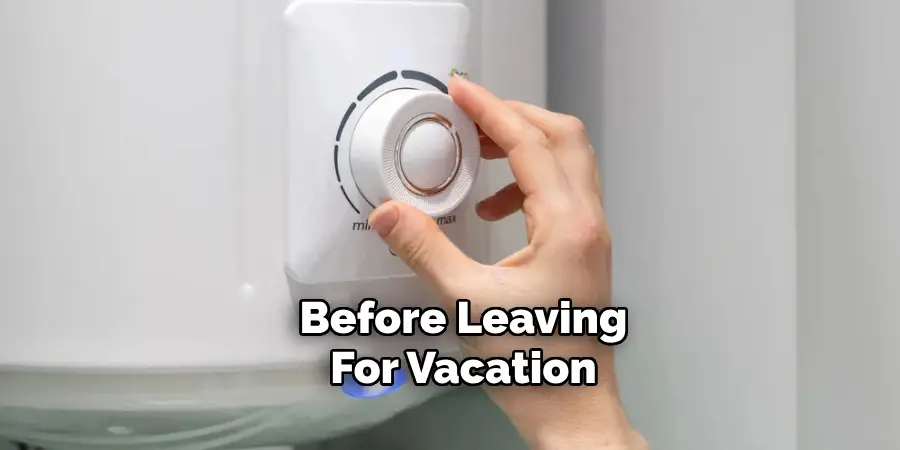
9. Inform a Neighbor or House Sitter
If you have a trusted neighbor or house sitter, inform them about your gas water heater and any specific instructions you have implemented. Provide them with your contact information and instructions on how to check the heater and address any potential issues. Having someone monitor your home while you’re away can provide peace of mind and ensure any problems are promptly addressed.
10. Perform Routine Maintenance Before Departure
Before turning off your gas water heater for vacation, perform routine maintenance to ensure it is in good working condition. This includes checking for leaks, inspecting the anode rod, and flushing the tank to remove sediment buildup. Regular maintenance helps prevent issues from arising while you’re away and ensures the water heater operates efficiently. By addressing any potential problems before your trip, you can leave with confidence knowing your water heater is in optimal condition.
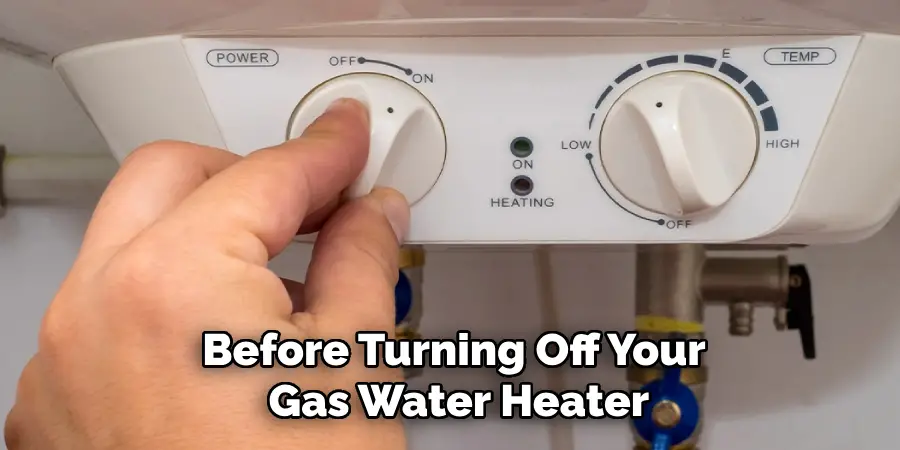
Safety Considerations Related to Gas Water Heaters
Ensuring the safe operation of gas water heaters is paramount for both the safety of occupants and the efficiency of the appliance. Here are several key safety considerations to keep in mind:
- Proper Ventilation: Adequate ventilation is crucial to prevent the buildup of harmful combustion gases, such as carbon monoxide. Ensure that the venting system is correctly installed and regularly inspected for blockages, corrosion, or disconnections. Clear any obstructions promptly to maintain proper airflow.
- Carbon Monoxide Detectors: Install carbon monoxide detectors near the gas water heater and throughout your home, especially in sleeping areas. These detectors can alert you to the presence of this odorless, colorless gas, providing an essential layer of protection against carbon monoxide poisoning.
- Regular Maintenance: Schedule routine inspections and maintenance by a qualified professional to check all components, including the burner, pilot light, venting system, and pressure relief valve. Regular maintenance can identify and rectify potential issues before they pose a safety hazard.
- Temperature Settings: To prevent scalding, never set the thermostat above 120°F (49°C). This temperature is sufficient to meet most household hot water needs while reducing the risk of burns.
- Gas Leaks: Be vigilant for any signs of a gas leak, such as a rotten egg smell. If you suspect a gas leak, turn off the gas supply immediately, evacuate the area, and contact your gas provider or emergency services. Never attempt to locate or fix a gas leak on your own.
- Flammable Materials: Keep flammable materials and liquids away from the water heater and surrounding area. Items such as cleaning solvents, gasoline, and other combustibles should be stored in a well-ventilated area, far from the appliance.
- Pressure Relief Valve: Regularly test the pressure relief valve to ensure it is functioning correctly. A malfunctioning valve can lead to excessive pressure buildup, which is hazardous. Replace the valve if it fails to release pressure during testing.
- Seismic Straps: In earthquake-prone areas, secure the water heater with seismic straps to prevent it from toppling over during seismic activity. This added measure can protect both the appliance and your home from damage.
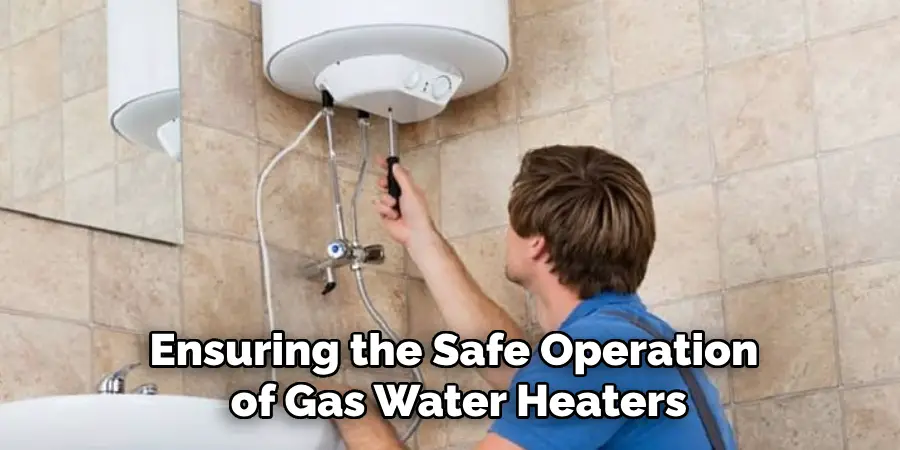
Conclusion
Properly maintaining and preparing your gas water heater for a vacation can save energy, enhance safety, and provide peace of mind. By following the steps outlined, such as adjusting the thermostat, insulating the tank, disconnecting the power supply, and ensuring the surrounding area is clear of hazards, you can protect your home and reduce the risk of issues arising while you’re away.
Safety considerations, including proper ventilation, the use of carbon monoxide detectors, and regular maintenance, are essential practices to ensure the efficient and secure operation of your gas water heater. Thanks for reading, and we hope this has given you some inspiration on how to turn off gas water heater for vacation!
You can check it out to Turn Off Water at Water Heater

